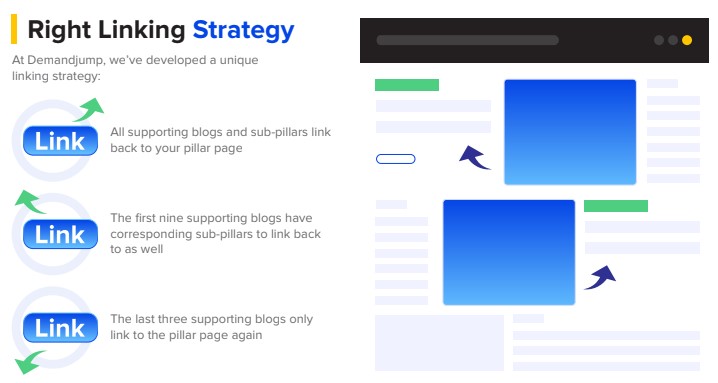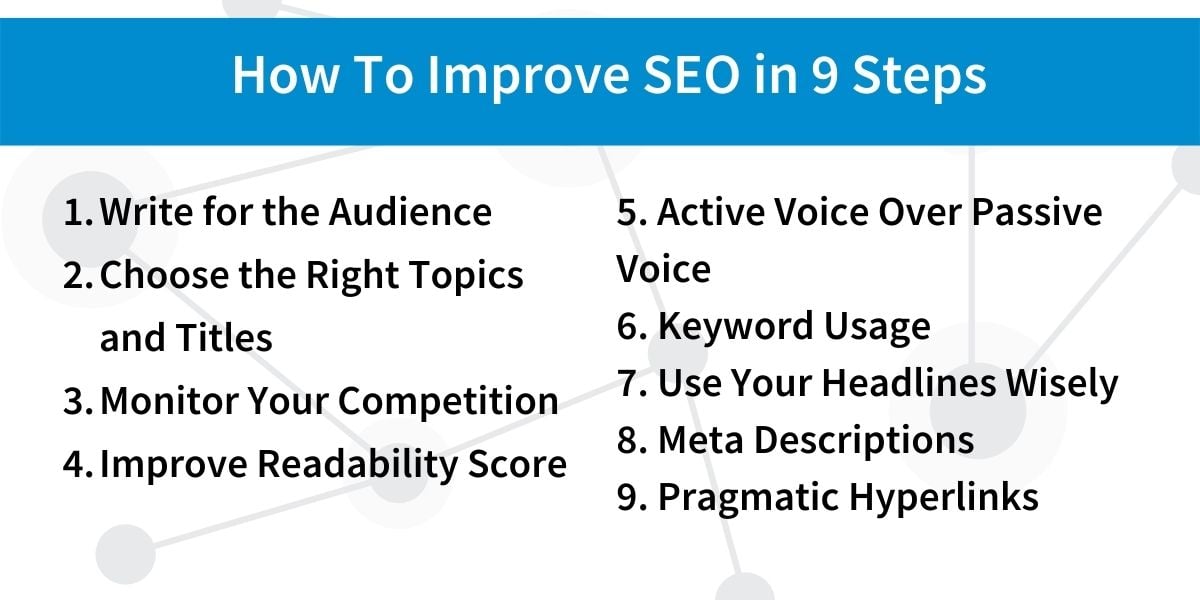Examples of SEO Writing: 9 Steps to Creating Great Content
June 17, 2021 •Clare Sheehan

Writing remains essential for businesses trying to improve their web content’s SEO. Stellar writing is required to make online content more appealing and accessible for users, generating more traffic. This means companies must develop a solid content marketing strategy and utilize the right keyword phrases to boost their appearance in search results.
Thankfully, the keyword-stuffed, automated texts of the past are no longer the SEO writing standard. At DemandJump, we know purposeful and informative content has a more significant impact on SEO relevance—otherwise, it becomes apparent you’re writing for robots, not humans.
Since we’re the content writing experts, we’ve created this guide to help you create unique content that’ll deliver the page one results you’ve been aiming for. To give you the most comprehensive overview possible, this guide has been split into two sections:
- A general overview of DemandJump’s SEO content writing practices
- 9 basic tips for SEO content writing
Part One: An Introduction to SEO Content Writing
Before we jump into our nine tips, we want to give you a brief overview of what SEO writing looks like and how it has changed in recent years. In this introduction, we will answer the following questions:
- What is SEO content writing?
- How do you create a successful SEO strategy?
- What is an SEO example?
- How does SEO work in digital marketing?
What Is SEO Writing?
The basic definition of SEO writing often sounds a bit like this: SEO writing is the practice of creating content designed to rank on the first page of search engines like Google. But, as is often the case in marketing, things are more complicated than they seem at first glance.
In today’s competitive digital market, the keyword-heavy and jargon-filled SEO writing techniques of the past just don’t cut it anymore. If companies are to successfully navigate the current marketing atmosphere, their SEO writing techniques must adapt alongside Google’s ever-evolving search algorithm. But with a seemingly endless amount of content being published every day, what SEO writing strategy can secure a spot on page one of Google? The answer: Pillar-Based Marketing (PBM).
Our PBM strategy is a targeted approach to SEO writing, designed to provide content that delivers relevant information to your target audience and answers their burning questions. This strategy also allows you to create an authoritative network of content, so Google recognizes your website as a reliable source of information, giving you an SEO boost.
The core of PBM is aligning your content with what your target audience is searching for. The DemandJump platform sifts through the complex network of searches to let you know exactly what topics to write about. After this analysis is completed, the platform gives you a targeted list of keyword phrases and questions you need to include in each piece of content—thus, your pillar-based strategy is born.
How To Do SEO Using a PBM Strategy
In simple terms, your PBM strategy revolves around three types of content:
- Your One Pillar Page: A pillar page is around 3,000 words in length, and provides a broad overview of your chosen topic. Each pillar page should include about 15-20 keywords.
- Your Three Sub-pillar Pages: Sub-pillars are around 2,000 words in length and describe a key topic from your pillar in more detail. Each sub-pillar page should include about 15 keywords.
- Your 12 Supporting Blogs: Blogs are around 750 words long and are designed to answer commonly searched questions related to your pillar and sub-pillar topics. Each blog should include about 8 keywords.
In the end, you will have 16 pieces of content total. All of this content should be linked together to create a solid network for Google to recognize your brand’s authority.

What Is an SEO Writing Example?
Okay, so we’ve explained a PBM strategy, but what does that look like in action? Look no further than DemandJump’s very own SEO Pillar. We created this pillar page following the PBM strategy guidelines we listed above. This SEO Pillar was the first article in a larger 16-piece PBM content strategy and served as the main piece in that cluster. Here are a few examples of the blogs and sub-pillars that are connected to this specific pillar plan:
Blogs:
- How Do You Create an Effective Topic Cluster and Pillar Page?
- How Do You Write a Pillar Page?
- Is a Pillar Page a Blog Post?
Sub-pillars:
- Pillar Page Outline
- Topic Clusters and Pillar Pages
- Topic Cluster Examples: Guides for Structuring Your Pillar Content
Feel free to explore our SEO Pillar page and see what a piece of PBM SEO writing looks like for yourself!
How SEO Works in Digital Marketing Today
The writing is on the wall, you won’t achieve SEO success with a single piece of content—you need to create a whole content ecosystem. Regarding SEO’s role and purpose in today’s digital marketing atmosphere, here’s what you need to remember.
- You should maintain a balance between writing for Google and writing for your audience. This can be a difficult task without the right strategy in place.
- Searches are getting increasingly complex, meaning people are asking highly detailed questions. Because of this, you need to include the top questions searched by your audience in all of your written content.
- Your content doesn’t matter if your website is slow or inaccessible.
- Use visuals and interactive web design to your advantage. People are more likely to read your content and trust your brand if your design matches the quality of the information you’re providing.

Part Two: How To Improve SEO in 9 Steps
Now that we have outlined the basics of a PBM SEO strategy, let’s talk about how to actually write more engaging and thoughtful content. Many assume that writing content is the easy part of SEO, but that’s a serious mistake. Even if you have the right strategy and keywords, a poorly written piece of content will cause your leads to quickly abandon your website, damaging trust with your audience. In the following section, we’ll provide some tips to help you write great SEO content.
1. Write for the Audience
No matter the topic, every audience wants to feel heard and like they are being spoken to on a personal level. Remember, you aren’t writing content for your company. You’re writing content for your reader. This means providing information your audience will find helpful above all else. For example, when it comes to writing valuable and informative SEO content, it’s best to avoid a strong sales pitch. Think of it this way—writing great content for your readers is less about explaining why your company is great and more about explaining how your company can help solve the reader’s pain points.
2. Choose the Right Topics and Titles
If you want to create a successful PBM campaign, you need to choose the perfect keyword titles for your pillar page, sub-pillars, and supporting blogs. DemandJump’s Insight Report function allows you to easily find these high-value keywords, taking guesswork out of the equation.
When choosing your ideal topic for each piece of content in your PBM strategy, you should pick things that:
- Address a specific pain point or question that’s being asked by your prospective customers.
- Align well with your brand’s mission, products/services, or competitive advantages.
3. Search Results Tell Us a Lot—Like What the Competition is Up To
Before writing or planning anything related to SEO, you need to have a handle on how your competition is approaching their content creation. This means reading their articles, taking note of how they are promoting their content, and discovering which high-value search terms they are ranking for. To make this an easier process, the DemandJump platform asks you to enter the names of your direct and indirect competitors into your account so you can see how you stack up against competition around any topic or keyword. This is critical to inform your SEO pillar strategy.
4. Improve Readability Score
When you observe high-ranking content, they all have extremely high readability scores. The sentences are shorter, the tone is conversational, word choice is simple, and you don’t see spelling or grammar mistakes. These all contribute to readability. Web tools like Grammarly actually create readability scores, which identify how accessible texts are. Identifying your audience’s preferred reading level is also an important aspect of improving your content’s readability.
5. Active Voice Over Passive Voice
This is one clear example of a writing rule you can use to improve the quality of your content. Let’s look at an example.
Active Voice: “We write content.”
Passive Voice: ”The content is written by us.”
In the second iteration, we use more words, making the meaning unclear. Brevity and clarity are key for SEO and audience accessibility.
6. Keyword Usage
As we mentioned above, each piece of content in a PBM strategy requires a certain number of keywords. When choosing these keywords, there are a few things you should keep in mind:
- Multiple relative keywords and synonyms show authenticity.
- Use your keywords to inform the structure of your content.
- Overuse doesn’t help. Stop counting.
- Meta descriptions and headers should use keywords without overuse.
7. Use Your Headlines Wisely
Choosing the right keywords for your H2s and other headings is another crucial tactic in SEO writing. It’s a best practice to choose high-value keyword questions as your H2s. When you use DemandJump, you will be able to see the top 25 questions associated with the search term you want to rank for. Using these as the headlines in your pillar page gives you direction and purpose when outlining your piece. Search engines look for those H2 tags that make content skimmable and well-organized. This also relates to readability: if your audience just skimmed headlines, what would be their takeaway?
8. Meta Descriptions
Meta descriptions are what you tell your website to display whenever your content appears in search results. The use of meta descriptions is two-fold: it’s a chance to highlight keywords and phrases—similar to headlines—and it also invites your audience to open the article, increasing traffic. Pay close attention to your meta descriptions because this might be more relevant to SEO and audience participation than the actual content.
9. Pragmatic Hyperlinks
In the PBM marketing section of this article, we described the Pillar-Based Marketing linking strategy. Although following the PBM linking strategy is important, there are additional rules to abide by when linking to outside sources in your content. Here are just a few hyperlinking best practices:
- Assess the trustworthiness of the domain you are linking to.
- Assess the popularity of the domain you are linking to. Your SEO can be adversely affected if you cite a non-authoritative source.
- Make sure that the content you are linking to is absolutely relevant.

Rise Above the Noise With DemandJump
It’s hard to write truly great SEO content on your own. DemandJump helps content creators build a purposeful SEO content marketing strategy. Our platform allows you to easily identify your audience, uncover the optimal keywords, and discover exactly what to write about to meet your digital marketing goals. But don’t take our word for it; try it for yourself!
Featured Articles
Categories
- Attribution Tracking (13)
- Channel Optimization (11)
- Consumer Insights (68)
- Content Marketing (251)
- Data Science (8)
- Digital Marketing (6)
- Digital Transformation (26)
- Enterprise (10)
- Lead Generation (14)
- Market Intelligence (8)
- Marketing Analytics (39)
- Marketing Attribution (57)
- Marketing Management (153)
- Marketing Operations (86)
- Organic Search (222)
- Paid Search (52)
- Pillar-Based Marketing (63)
- Programmatic Advertising (9)
- SaaS Content (14)
- SaaS Marketing (29)
- Search Marketing (111)
- SEO Keyword Research (28)
- SEO Pillar (18)
- SEO Strategy (46)
- SMB (5)
- Website Content (12)


